Abstract
There are no reports investigating the relationship between shoulder range of motion (ROM) and pitching elbow torque in junior high school pitchers. Therefore, we aimed to evaluate the factors associated with medial elbow torque in this population. Sixty-three junior high school baseball pitchers were recruited for this study. The participants completed a questionnaire and passive ROM measurements of shoulder abduction and horizontal adduction. All pitchers pitched three fastballs at maximum effort while wearing a wireless sensor recording pitching mechanics and elbow valgus torque for each pitch. Age (r = 0.65, p < 0.001), height (r = 0.83, p < 0.001), body weight (r = 0.82, p < 0.001), BMI (r = 0.60, p < 0.001), and ball velocity (r = 0.80, p < 0.001) were significantly positively correlated with elbow valgus torque. Participants were divided into two groups based on elbow valgus torque, >30 (high torque [HT]) and <30 N·m (low torque [LT]). Age, height, body weight, BMI, and ball velocity were significantly higher in the HT group than in the LT group. The difference between dominant and non-dominant shoulder horizontal adduction ROM was 5.3 ± 9.3° and 1.0 ± 6.4° in the HT and LT groups, respectively, which was also significantly different. Ball velocity, age, larger physique, and increased restriction of the dominant shoulder’s horizontal adduction ROM were associated with higher medial elbow torque in junior high school pitchers. This suggests that improving the dominant shoulder’s horizontal adduction ROM contributes to preventing elbow injuries.
1. Introduction
Baseball pitchers experience 67% of all injuries to the upper extremity, of which elbow injuries are the most common [1]. In recent years, there has been an increase in elbow injuries in youth baseball pitchers, particularly those related to the ulnar collateral ligament (UCL) [2]. The UCL is the primary stabilizer for elbow valgus stress during pitching and is involved in medial elbow joint stability [3,4]. During the cocking phase of the pitching motion, the maximum elbow valgus torque is estimated to reach 64 N·m [5]. In addition, researchers implementing cadaver-based research have found that the ultimate valgus torque resistance strength of the UCL is approximately 30 N·m [6,7]. This means that the UCL itself might be injured by the valgus stress of pitching, and pitchers are at a higher risk of UCL injury due to microtrauma caused by repetitive pitching stress. Due to the prevalence of UCL injury, UCL reconstruction has been increasingly performed on youth and high school baseball players [8]. In youth baseball players, osteochondritis dissecans (OCD) of the capitellum is also a leading cause of elbow disability [9]. While overuse of pitching is considered the primary risk factor for developing elbow injuries, several other risk factors such as age of 9–11 years, role of pitcher or catcher, and history of elbow pain have also been suggested as significant risk factors for these injuries in youth baseball players [5,10,11]. Elbow and shoulder injuries are also associated with physical characteristics such as relative muscle stiffness during the growth spurt [12]. In addition, the frequency of shoulder and elbow pain in junior high school players has been reported to be 1.6 times more common than in elementary school players [13].
To reduce the incidence of such throwing injuries and the requirement for surgical intervention, restrictions on pitch counts and breaks between pitching sessions have been introduced [14], and elbow examinations for youth baseball players have been recently conducted to detect OCD in its early stages. The effects of pitching mechanics [14,15,16,17], the number and type of pitches [18,19], and ball velocity [14,20] on the elbow torque of youth baseball players have been reported. A wearable sensor detecting pitching mechanics and elbow stress (PULSE THROW; DRIVELINE BASEBALL, Kent, WA, USA; Figure 1) has been reported to be used for research on medial elbow torque [14,21,22]. Okoroha et al. described that increased ball velocity and body mass index (BMI) and decreased arm slot were predictors of elbow torque among youth and adolescent baseball pitchers, but shoulder ROM was not investigated, the age range was 12–17 years, and the number of subjects was only 20, a small number [14]. Other reports using the same sensor have investigated the relationship between different types of pitches, glenohumeral internal rotation deficit (GIRD), and elbow torque, but the subjects were high school and college baseball players [21,22]. In high school baseball pitchers, GIRD was not associated with medial elbow torque during the pitching motion [22]. There are no reports showing a relationship between physical characteristics such as shoulder joint range of motion (ROM) and pitching elbow torque in youth baseball players, and no established methods of preventing throwing elbow disorders other than reducing the number of pitches thrown. As mentioned above, there are various reports on factors related to medial elbow torque, but a definite view has not been reached. Furthermore, there have been no studies limited to junior high school baseball players.
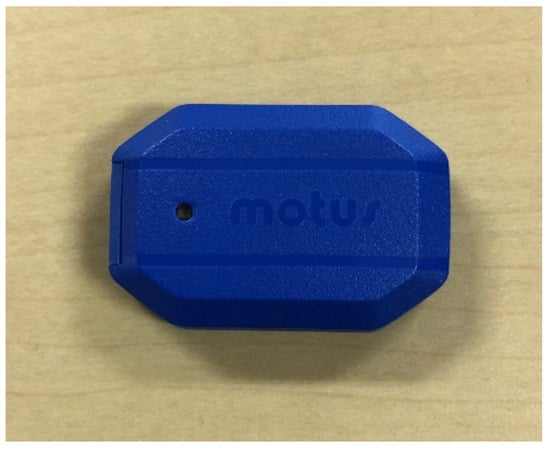
Figure 1.
PULSE THROW sensor.
Given this background, we hypothesized that in growing junior high school baseball players, in addition to ball velocity and physique, shoulder joint ROM restrictions would be also related to pitching elbow torque. Therefore, this study aimed to examine the relationship between the elbow valgus torque during pitching, measured by using a wearable sensor (PULSE THROW), ball velocity, pitching motion measurements, and physical characteristics, including shoulder joint ROM in junior high school baseball pitchers.
2. Materials and Methods
2.1. Ethics Statement
Every experiment was conducted with the approval and guidance of the institute’s Ethics Committee, and informed consent was obtained from all participants and their parents.
2.2. Participants’ Background
Medical checkups were conducted for elementary and junior high school baseball players, with 860 players participating, which included a questionnaire, shoulder range of motion measurements, and pitching measurements. Of those, 63 junior high school baseball pitchers volunteered to participate in this study during medical checkups without any significant injuries at the time of examination. To determine the sample size, a power analysis based on data from a prior study using G*Power 3.1 was used [23]. After calculating a preliminary sample size, the difference in glenohumeral internal rotation deficits (GIRD) between the UCL failure group and the control group (n = 21 per group) was shown with a t-test (effect size = 0.8, α = 0.05, power = 0.8). Players completed a questionnaire regarding age, height, body weight, dominant arm, baseball career duration, and history of shoulder and elbow injuries or surgeries.
The inclusion criteria consisted of junior high school pitchers measured for pitching during medical checkups. Excluded from eligibility criteria included those with a history of significant injuries or surgery to the shoulder or elbow and those having a significant injury present on examination (Figure 2). All examinations were conducted at the end of the season medical checkup. The experimental flow chart and measurement parameters are shown in Figure 3.
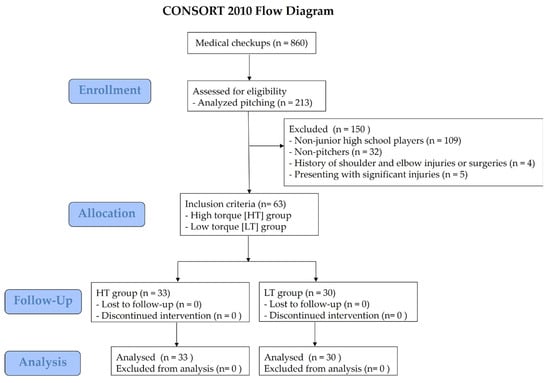
Figure 2.
CONSORT flow diagram.
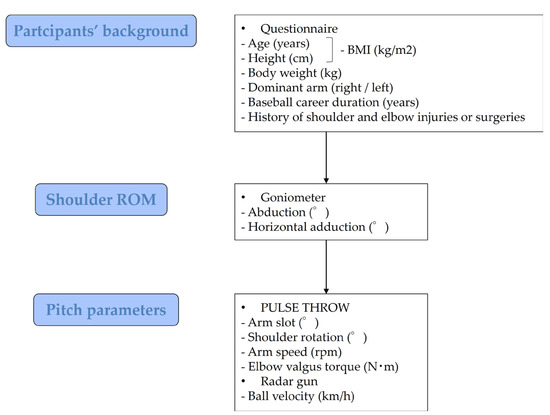
Figure 3.
Experimental flow chart and measurement parameters.
2.3. Shoulder ROM
Passive shoulder ROMs in both abduction and horizontal adduction were examined using a conventional procedure encouraged by the American Academy of Orthopaedic Surgeons [24], placing the participants supine on a portable examination table and using a goniometer (Figure 4). In measuring shoulder abduction ROM, the first investigator immobilized the subject’s scapulothoracic joint by restraining the subject’s scapula with one hand, and passively induced shoulder joint abduction with the other hand until resistance was felt. The angle of abduction was measured by the second investigator as the angle between the long axis of the trunk and the upper arm. Horizontal adduction was similarly assessed with the scapulothoracic joint fixed. The humerus was then horizontally adducted while maintaining neutral rotation of the humerus until resistance was felt. The angle of horizontal adduction was measured as the angle between the horizontal plane and the long axis of the humerus. Shoulder ROM was recorded prior to performing the pitching exercises. As in the previous report, each measurement was taken twice, and the mean values were used for analysis [25]. The difference between the dominant and non-dominant shoulders’ ROM was also evaluated. The difference between the dominant and non-dominant shoulders’ ROM was defined as the following:
The difference between the dominant and non-dominant shoulders’ ROM = non-dominant shoulders’ ROM − dominant shoulders’ ROM (°)
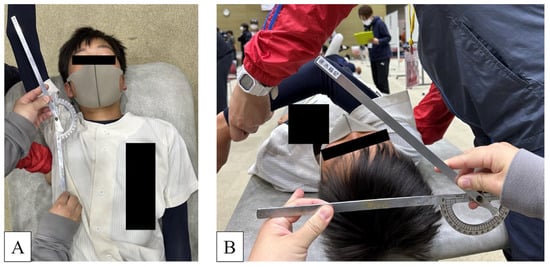
Figure 4.
Passive ROM measurements of shoulder abduction (A) and horizontal adduction (B).
2.4. Pitch Parameters
Pitch parameters, including medial elbow torque measurements, were measured using a wearable sensor (PULSE THROW). The participants for the pitch measurement had an arm sleeve with the sensor inserted in the pocket. In accordance with the manufacturer’s instructions, the sensor was placed approximately 5 cm distal to the medial epicondyle of the humerus (Figure 5), and it was instructed that each of the players warm up with a routine of their preference before pitching. All pitchers pitched three fastballs at maximum effort while wearing PULSE THROW that can record the arm slot (angle of the forearm in relation to the ground at release; in °), shoulder rotation (maximum angle of the forearm during late cocking phase; in °), arm speed (peak rotational velocity of the forearm; in rotations per minute [rpm]), and elbow valgus torque (measured by a gyrometer and accelerometer in the sensor; in N·m) for each pitch.
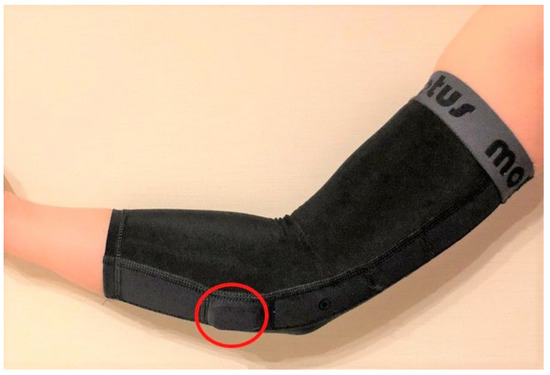
Figure 5.
The compression arm sleeve with the elbow torque sensor (red circle) positioned 5 cm distal to the medial epicondyle of the humerus.
The sensor data was shown and recorded in an accompanying smartphone application provided by the manufacturer. All pitch parameters evaluated by the sensor were validated against the gold standard motion analysis outlined by a recent study [26,27]. Each pitch was performed at a distance of 18.44 m to the catcher. Sensor position was checked between each pitch to ensure the proper position. Each peak ball velocity (km/h) was measured with a radar gun (Stalker Sport II; Stalker, Plano, TX, USA), which was positioned behind the catcher.
2.5. Statistical Analysis
Statistical analysis was performed to ensure that all data were normally distributed by the Shapiro-Wilk test. All data are expressed as the mean ± standard deviation (SD). All statistical analyses were performed using SPSS (version 27.0; SPSS Inc., Chicago, IL, USA). The association between elbow valgus torque, medial elbow stress during pitching, and physical characteristics, including shoulder ROM and other pitch parameter measurements, was tested by the Pearson correlation coefficient. Significant between-group differences were determined using independent t-tests. Statistical significance was set at p < 0.05.
3. Results
3.1. Participants’ Background
Participants’ mean age, height, body weight, and BMI were 13.6 years (range, 12–15 years), 166.4 cm (range, 140–182 cm), 57.7 kg (range, 35–85 kg), and 20.7 kg/m2 (range, 16.4–28.0 kg/m2) (Table 1). Forty-eight players were right-handed and 15 were left-handed. The mean career duration of the baseball players was 6.3 years (range, 2–11 years). Participants’ background characteristics in each group are summarized in Table 1. Age (r = 0.65, p < 0.001), height (r = 0.83, p < 0.001), body weight (r = 0.82, p < 0.001), and BMI (r = 0.60, p < 0.001) were significantly positively correlated with elbow stress (Table 2, Figure 6). In a between-group comparison, age (HT, 14.1 ± 0.6 years; LT, 13.2 ± 0.6 years; p < 0.001), height (HT, 170.7 ± 4.9 cm; LT, 161.5 ± 6.6 cm; p < 0.001), body weight (HT, 63.6 ± 8.8 kg; LT, 51.2 ± 7.1 kg; p < 0.001), and BMI (HT, 21.8 ± 2.5 kg/m2; LT, 19.6 ± 2.0 kg/m2; p < 0.001) were significantly higher in the HT group than in the LT group (Table 1).

Table 1.
Participants’ background characteristics.

Table 2.
Correlations with elbow stress.
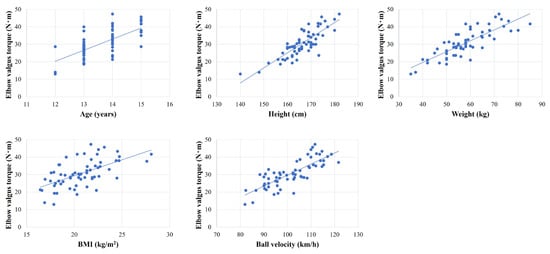
Figure 6.
Correlations with elbow stress. Elbow valgus torque was significantly positively correlated with age, height, weight, body mass index (BMI), and ball velocity.
3.2. Pitch Parameters
The overall mean pitch parameter measurements are shown in Table 3. The mean elbow valgus torque was 30.6 ± 7.7 N·m. Ball velocity was significantly positively correlated with elbow valgus torque (r = 0.80, p < 0.001), while no significant correlations were found between elbow valgus torque and the other pitching motion parameters measured by the wearable sensor (Table 2, Figure 6). Subsequently, all participants were divided into two groups based on the mean elbow valgus torque measured in this study and the ultimate valgus torque resistance strength of the UCL in previous reports [3,10]: the >30 (high torque [HT]; n = 33) and <30 N·m (low torque [LT]; n = 30) groups. Between-group pitch parameters and physical factors were then analyzed. Elbow valgus torque was 36.4 ± 5.1 and 24.3 ± 4.4 N·m in the HT and LT groups, respectively, with a significant between-group difference (p < 0.001). Ball velocity was also significantly higher in the HT group (HT, 107.1 ± 8.4 km/h; LT, 95.3 ± 6.9 km/h; p < 0.001), whereas no significant between-group differences were found in the other pitch parameters (Table 3).

Table 3.
Pitch parameter measurements.
3.3. Shoulder ROM
The mean shoulder ROM measurements recorded are shown in Table 4. The dominant shoulder showed decreased horizontal adduction ROM relative to the non-dominant side (dominant side 99.7 ± 7.1°; non-dominant side 102.5 ± 8.6°; p = 0.02). No significant correlation with elbow stress was found for shoulder ROM (Table 3). In the between-group evaluation, the difference between the dominant and non-dominant shoulders’ horizontal adduction ROM was 5.3 ± 9.3 and 1.0 ± 6.4° in the HT and LT groups, respectively, with a significant difference (p = 0.03). There was no significant between-group difference regarding shoulder abduction ROM (Table 4).

Table 4.
Shoulder range of motion measurements.
4. Discussion
This study investigated the relationship between elbow valgus torque during pitching and ball velocity, pitching motion measurements, and physical characteristics, including shoulder joint ROM, in junior high school baseball pitchers. We found that increased ball velocity, age, height, body weight, BMI, and restricted dominant shoulder horizontal adduction ROM compared to that of the non-dominant shoulder were associated with higher medial elbow torque. As far as we know, this is the first study to demonstrate the impact of dominant shoulder horizontal adduction restriction on the higher elbow valgus torque in junior high school baseball pitchers.
Excessive torque in the medial elbow’s connective tissue is an important factor in elbow joint injuries in overhead athletes [5,21,28]. The higher elbow valgus torque and higher shoulder external rotation torque at the time of maximum external rotation of the shoulder in the late cocking phase were significantly correlated with elbow injuries. [29]. The PULSE THROW used in this study measured the peak elbow valgus torque placed on the medial elbow around the time of maximum shoulder external rotation during pitching [21]. The reliability of measurements from wearable sensors, including elbow valgus torque, has been verified by comparison with motion capture [26,27].
Adaptations in shoulder ROM are found among baseball players as a result of repetitive throwing [30,31,32,33]. A greater ROM deficit in the dominant throwing shoulder reportedly increases the risk of injury 2.5- to 9-fold [34,35]. In particular, the significant risk factors for the development of pitching-related injuries, including UCL tears, are GIRD and the total arc of motion deficits [23,36]. Baseball players with posterior shoulder tightness have been reported to be associated with shoulder ROM deficits in glenohumeral internal rotation and horizontal adduction [37]. In the present study, dominant shoulder horizontal adduction deficits compared to the non-dominant shoulder are related to higher elbow valgus torque during pitching.
Mifune et al. reported that the infraspinatus and lower trapezius contribute to posterior shoulder tightness [25], and Yamaura et al. indicated that pitching significantly increased muscle elasticity even after 24 h [38]. It was also demonstrated that improving shoulder internal rotation ROM by stretching the posterior shoulder muscles daily was associated with a 36% risk reduction for shoulder and elbow injuries [39]. Modified cross-body stretching and modified sleeper stretching for shoulder ROM and muscle stiffness in baseball players with posterior shoulder stiffness are effective in increasing shoulder internal rotation and horizontal adduction ROM and decreasing muscle stiffness of the infraspinatus or teres minor [40]. As such, improving posterior shoulder tightness and increasing shoulder range of motion may reduce elbow stress and prevent pitching injuries.
Evaluating the effects of ball velocity on elbow torque is controversial. Asymptomatic collegiate pitchers were evaluated by motion analysis and no association was found between ball velocity and elbow valgus torque [41]. However, an association between fastball velocity and elbow stress was found by evaluating high school pitchers without injuries using motion analysis [42]. There have been several other reports of ball velocity being associated with medial elbow torque and elbow injuries [14,20,22,43]. Similar to those results, higher elbow valgus torque was significantly associated with increased ball velocity in this study.
Pitching mechanics constitute a complex movement that generates significant forces and places a great deal of strain on the soft tissue restraints of the upper extremity [5]. In correlations between pitching mechanics and elbow valgus load, increased elbow valgus stress during pitching has been observed in baseball pitchers with larger maximum shoulder external rotation angles, smaller elbow flexion at peak valgus torque, and side throws [44]. Okoroha et al. found that among youth and adolescent baseball pitchers, increased BMI and decreased arm slot were predictors of medial elbow torque measured by the wearable sensor (PULSE THROW), whereas increasing age were protectors against elbow torque [14]. As for BMI, Tresca stress has been reported to increase with a higher BMI category [45], but there is no detailed discussion of the relationship between pitching biomechanics and BMI. Smith et al. also demonstrated that age and height were predictors of medial elbow torque using the same sensor [22]. In this study, in junior high school pitchers, increased age, height, body weight, and BMI were associated with higher elbow valgus torque evaluated by the same wearable sensor while pitching mechanics, including arm slot, shoulder rotation, and arm speed were not significantly related to elbow valgus torque.
This study is not without limitations. First, it is impossible to determine whether the torque measured medially at the elbow using wearable sensors during the throwing motion is a true measure of stress on the UCL during pitching. However, relative values measured indirectly by gyrometers and accelerometers are useful in clinical and research settings and can be reliably measured using this device, as shown in previous studies and this study [14,22,27]. Further research will accumulate pitching data using this wearable sensor, and if it is possible to determine the average pitching elbow torque for each age group and the cut-off value at which pitching elbow injury can occur, this sensor may be used to prevent pitching injury. Second, the criteria for dividing the two groups by the value of elbow valgus torque was set at the mean value of 30 N·m. However, no significant differences in subject numbers were found between the groups, although they were divided into groups based on mean values. In addition, based on reports that young pitchers experience ~28 N·m of elbow valgus stress and the valgus torque resistance strength of the UCL is about 30 N·m, it seems that there is no major problem in setting this standard value [5,6,7]. Third, the only physical examination findings in this study measured ROM of shoulder abduction and horizontal adduction. Pitching injury has also been suggested to be influenced by GIRD, the total arc of motion deficits, and lower limb tightness [12,23,36], so as a future study, we intend to measure those physical findings as well and investigate their relationship to pitching elbow torque. Finally, all subjects did not have elbow injuries, so it is unknown how larger elbow valgus torque measured by this wearable sensor affects the development of pitching elbow injuries in junior high school baseball pitchers. It was found that higher pitching elbow torque in junior high school baseball pitchers may be influenced by increased age, height, weight, BMI, ball velocity, and dominant posterior shoulder tightness. However, this is a single time-point study, and it is unclear whether this study’s results were the cause or result of the association with elbow stress. Therefore, a longitudinal study is currently being conducted to investigate this further.
5. Conclusions
This study showed that increased restriction of the dominant shoulder’s horizontal adduction ROM compared to the non-dominant shoulder, ball velocity, age, and larger physique were associated with higher medial elbow torque in junior high school pitchers. To our knowledge, this study is the first to limit junior high school baseball players regarding factors associated with medial elbow torque measured using a wearable sensor (PULSE THROW) and to demonstrate the influence of dominant shoulder horizontal adduction restriction on higher elbow valgus torque. These results indicate that improving restricted shoulder horizontal adduction ROM by stretching might decrease elbow valgus torque during pitching, protect the UCL, and ultimately prevent throwing elbow injuries.
Author Contributions
Conceptualization, T.Y., A.I., Y.M. and H.N.; methodology, T.Y. and A.I.; software, A.I.; validation, T.Y., Y.M., A.I. and H.N.; formal analysis, A.I.; investigation, T.Y., K.Y., S.M., I.S., T.K., T.F., M.K., S.T., Y.H. and T.M.; resources, Y.M.; data curation, T.Y.; writing—original draft preparation, T.Y.; writing—review and editing, T.Y., A.I. and Y.M.; visualization, T.Y.; supervision, R.K.; project administration, A.I.; funding acquisition, Y.M. All authors have read and agreed to the published version of the manuscript.
Funding
This research received no external funding.
Institutional Review Board Statement
The study was conducted in accordance with the Declaration of Helsinki, and approved by the Ethics Committee at Kobe University Graduate School of Medicine (protocol code: B210009 and date of approval: 21 April 2021).
Informed Consent Statement
Informed consent was obtained from all subjects involved in the study. Written informed consent has been obtained from the patients and their parents to publish this paper.
Data Availability Statement
The datasets generated during and analyzed during the current study are not publicly available due to the inclusion of unpublished data but are available from the corresponding author on reasonable request.
Conflicts of Interest
The authors declare no conflict of interest. The funders had no role in the design of the study; in the collection, analyses, or interpretation of data; in the writing of the manuscript; or in the decision to publish the results.
References
- Posner, M.; Cameron, K.L.; Wolf, J.M.; Belmont, P.J., Jr.; Owens, B.D. Epidemiology of Major League Baseball injuries. Am. J. Sports Med. 2011, 39, 1676–1680. [Google Scholar] [CrossRef] [PubMed]
- Hodgins, J.L.; Vitale, M.; Arons, R.R.; Ahmad, C.S. Epidemiology of Medial Ulnar Collateral Ligament Reconstruction: A 10-Year Study in New York State. Am. J. Sports Med. 2016, 44, 729–734. [Google Scholar] [CrossRef] [PubMed]
- Morrey, B.F.; An, K.N. Functional anatomy of the ligaments of the elbow. Clin. Orthop. Relat. Res. 1985, 201, 84–90. [Google Scholar] [CrossRef]
- Morrey, B.F.; Tanaka, S.; An, K.N. Valgus stability of the elbow. A definition of primary and secondary constraints. Clin. Orthop. Relat. Res. 1991, 265, 187–195. [Google Scholar] [CrossRef]
- Fleisig, G.S.; Andrews, J.R.; Dillman, C.J.; Escamilla, R.F. Kinetics of baseball pitching with implications about injury mechanisms. Am. J. Sports Med. 1995, 23, 233–239. [Google Scholar] [CrossRef]
- Ahmad, C.S.; Lee, T.Q.; ElAttrache, N.S. Biomechanical evaluation of a new ulnar collateral ligament reconstruction technique with interference screw fixation. Am. J. Sports Med. 2003, 31, 332–337. [Google Scholar] [CrossRef] [PubMed]
- Dillman, C.J. Valgus extension overload in baseball pitching. Med. Sci. Sports Exerc. 1991, 23, S153. [Google Scholar]
- Fleisig, G.S.; Andrews, J.R. Prevention of elbow injuries in youth baseball pitchers. Sports Health 2012, 4, 419–424. [Google Scholar] [CrossRef]
- Matsuura, T.; Iwame, T.; Iwase, J.; Sairyo, K. Osteochondritis Dissecans of the Capitellum :Review of the Literature. J. Med. Investig. 2020, 67, 217–221. [Google Scholar] [CrossRef]
- Agresta, C.E.; Krieg, K.; Freehill, M.T. Risk Factors for Baseball-Related Arm Injuries: A Systematic Review. Orthop. J. Sports Med. 2019, 7, 2325967119825557. [Google Scholar] [CrossRef]
- Yang, J.; Mann, B.J.; Guettler, J.H.; Dugas, J.R.; Irrgang, J.J.; Fleisig, G.S.; Albright, J.P. Risk-Prone Pitching Activities and Injuries in Youth Baseball: Findings from a National Sample. Am. J. Sports Med. 2014, 42, 1456–1463. [Google Scholar] [CrossRef] [PubMed]
- Endo, Y.; Sakamoto, M. Correlation of shoulder and elbow injuries with muscle tightness, core stability, and balance by longitudinal measurements in junior high school baseball players. J. Phys. Ther. Sci. 2014, 26, 689–693. [Google Scholar] [CrossRef]
- Takagishi, K.; Matsuura, T.; Masatomi, T.; Chosa, E.; Tajika, T.; Watanabe, M.; Iwama, T.; Otani, T.; Inagaki, K.; Ikegami, H.; et al. Shoulder and elbow pain in elementary school baseball players: The results from a nation-wide survey in Japan. J. Orthop. Sci. 2017, 22, 682–686. [Google Scholar] [CrossRef] [PubMed]
- Okoroha, K.R.; Lizzio, V.A.; Meta, F.; Ahmad, C.S.; Moutzouros, V.; Makhni, E.C. Predictors of Elbow Torque among Youth and Adolescent Baseball Pitchers. Am. J. Sports. Med. 2018, 46, 2148–2153. [Google Scholar] [CrossRef] [PubMed]
- Davis, J.T.; Limpisvasti, O.; Fluhme, D.; Mohr, K.J.; Yocum, L.A.; Elattrache, N.S.; Jobe, F.W. The effect of pitching biomechanics on the upper extremity in youth and adolescent baseball pitchers. Am. J. Sports Med. 2009, 37, 1484–1491. [Google Scholar] [CrossRef] [PubMed]
- Keeley, D.W.; Hackett, T.; Keirns, M.; Sabick, M.B.; Torry, M.R. A biomechanical analysis of youth pitching mechanics. J. Pediatr. Orthop. 2008, 28, 452–459. [Google Scholar] [CrossRef] [PubMed]
- Thompson, S.F.; Guess, T.M.; Plackis, A.C.; Sherman, S.L.; Gray, A.D. Youth Baseball Pitching Mechanics: A Systematic Review. Sports Health 2018, 10, 133–140. [Google Scholar] [CrossRef] [PubMed]
- Lyman, S.; Fleisig, G.S.; Andrews, J.R.; Osinski, E.D. Effect of pitch type, pitch count, and pitching mechanics on risk of elbow and shoulder pain in youth baseball pitchers. Am. J. Sports Med. 2002, 30, 463–468. [Google Scholar] [CrossRef]
- Lyman, S.; Fleisig, G.S.; Waterbor, J.W.; Funkhouser, E.M.; Pulley, L.; Andrews, J.R.; Osinski, E.D.; Roseman, J.M. Longitudinal study of elbow and shoulder pain in youth baseball pitchers. Med. Sci. Sports Exerc. 2001, 33, 1803–1810. [Google Scholar] [CrossRef]
- Olsen, S.J., 2nd; Fleisig, G.S.; Dun, S.; Loftice, J.; Andrews, J.R. Risk factors for shoulder and elbow injuries in adolescent baseball pitchers. Am. J. Sports Med. 2006, 34, 905–912. [Google Scholar] [CrossRef]
- Makhni, E.C.; Lizzio, V.A.; Meta, F.; Stephens, J.P.; Okoroha, K.R.; Moutzouros, V. Assessment of Elbow Torque and Other Parameters during the Pitching Motion: Comparison of Fastball, Curveball, and Change-up. Arthroscopy 2018, 34, 816–822. [Google Scholar] [CrossRef] [PubMed]
- Smith, D.G.; Swantek, A.J.; Gulledge, C.M.; Lizzio, V.A.; Bermudez, A.; Schulz, B.M.; Mekhni, E.C. Relationship Between Glenohumeral Internal Rotation Deficit and Medial Elbow Torque in High School Baseball Pitchers. Am. J. Sports Med. 2019, 47, 2821–2826. [Google Scholar] [CrossRef] [PubMed]
- Dines, J.S.; Frank, J.B.; Akerman, M.; Yocum, L.A. Glenohumeral internal rotation deficits in baseball players with ulnar collateral ligament insufficiency. Am. J. Sports Med. 2009, 37, 566–570. [Google Scholar] [CrossRef] [PubMed]
- Heck, I.E.; Hendryson, I.E.; Rowe, C.R. Joint Motion: Method of Measuring and Recording; American Academy of Orthopaedic Surgeons: Chicago, IL, USA, 1965. [Google Scholar]
- Mifune, Y.; Inui, A.; Nishimoto, H.; Kataoka, T.; Kurosawa, T.; Yamaura, K.; Mukohara, S.; Niikura, T.; Kokobu, T.; Akisue, T.; et al. Assessment of posterior shoulder muscle stiffness related to posterior shoulder tightness in college baseball players using shear wave elastography. J. Shoulder Elbow Surg. 2020, 29, 571–577. [Google Scholar] [CrossRef] [PubMed]
- Boddy, K.J.; Marsh, J.A.; Caravan, A.; Lindley, K.E.; Scheffey, J.O.; O’Connell, M.E. Exploring wearable sensors as an alternative to marker-based motion capture in the pitching delivery. PeerJ 2019, 7, e6365. [Google Scholar] [CrossRef] [PubMed]
- Camp, C.L.; Tubbs, T.G.; Fleisig, G.S.; Dines, J.S.; Dines, D.M.; Altchek, D.W.; Dowling, B. The Relationship of Throwing Arm Mechanics and Elbow Varus Torque: Within-Subject Variation for Professional Baseball Pitchers across 82,000 Throws. Am. J. Sports Med. 2017, 45, 3030–3035. [Google Scholar] [CrossRef] [PubMed]
- Wilk, K.E.; Meister, K.; Andrews, J.R. Current concepts in the rehabilitation of the overhead throwing athlete. Am. J. Sports Med. 2002, 30, 136–151. [Google Scholar] [CrossRef] [PubMed]
- Anz, A.W.; Bushnell, B.D.; Griffin, L.P.; Noonan, T.J.; Torry, M.R.; Hawkins, R.J. Correlation of torque and elbow injury in professional baseball pitchers. Am. J. Sports Med. 2010, 38, 1368–1374. [Google Scholar] [CrossRef]
- Burkhart, S.S.; Morgan, C.D.; Kibler, W.B. The disabled throwing shoulder: Spectrum of pathology Part I: Pathoanatomy and biomechanics. Arthroscopy 2003, 19, 404–420. [Google Scholar] [CrossRef]
- Myers, J.B.; Laudner, K.G.; Pasquale, M.R.; Bradley, J.P.; Lephart, S.M. Glenohumeral range of motion deficits and posterior shoulder tightness in throwers with pathologic internal impingement. Am. J. Sports Med. 2006, 34, 385–391. [Google Scholar] [CrossRef]
- Ruotolo, C.; Price, E.; Panchal, A. Loss of total arc of motion in collegiate baseball players. J. Shoulder Elbow Surg. 2006, 15, 67–71. [Google Scholar] [CrossRef] [PubMed]
- Yamaura, K.; Mifune, Y.; Inui, A.; Nishimoto, H.; Kurosawa, T.; Mukohara, S.; Yoshikawa, T.; Hoshino, Y.; Niikura, T.; Kokobu, T. Relationship between glenohumeral internal rotation deficit and shoulder conditions in professional baseball pitchers. J. Shoulder Elbow Surg. 2021, 30, 2073–2081. [Google Scholar] [CrossRef] [PubMed]
- Salamh, P.A.; Kolber, M.J.; Hanney, W.J. Effect of scapular stabilization during horizontal adduction stretching on passive internal rotation and posterior shoulder tightness in young women volleyball athletes: A randomized controlled trial. Arch. Phys. Med. Rehabil. 2015, 96, 349–356. [Google Scholar] [CrossRef]
- Wilk, K.E.; Hooks, T.R.; Macrina, L.C. The modified sleeper stretch and modified cross-body stretch to increase shoulder internal rotation range of motion in the overhead throwing athlete. J. Orthop. Sports Phys. Ther. 2013, 43, 891–894. [Google Scholar] [CrossRef]
- Garrison, J.C.; Cole, M.A.; Conway, J.E.; Macko, M.J.; Thigpen, C.; Shanley, E. Shoulder range of motion deficits in baseball players with an ulnar collateral ligament tear. Am. J. Sports Med. 2012, 40, 2597–2603. [Google Scholar] [CrossRef] [PubMed]
- Bailey, L.B.; Shanley, E.; Hawkins, R.; Beattie, P.F.; Fritz, S.; Kwartowitz, D.; Thigpen, C.A. Mechanisms of Shoulder Range of Motion Deficits in Asymptomatic Baseball Players. Am. J. Sports Med. 2015, 43, 2783–2793. [Google Scholar] [CrossRef] [PubMed]
- Yamaura, K.; Mifune, Y.; Inui, A.; Nishimoto, H.; Kataoka, T.; Kurosawa, T.; Mukohara, S.; Niikura, T.; Kokobu, T.; Kuroda, R. Sequential Changes in Posterior Shoulder Muscle Elasticity After Throwing as Assessed via Ultrasound Shear Wave Elastography. Orthop. J. Sports Med. 2021, 9, 23259671211021362. [Google Scholar] [CrossRef]
- Matsel, K.A.; Butler, R.J.; Malone, T.R.; Hoch, M.C.; Westgate, P.M.; Uhl, T.L. Current Concepts in Arm Care Exercise Programs and Injury Risk Reduction in Adolescent Baseball Players: A Clinical Review. Sports Health 2021, 13, 245–250. [Google Scholar] [CrossRef]
- Yamauchi, T.; Hasegawa, S.; Nakamura, M.; Nishishita, S.; Yanase, K.; Fujita, K.; Umehara, J.; Ji, X.; Ibuki, S.; Ichihashi, N. Effects of two stretching methods on shoulder range of motion and muscle stiffness in baseball players with posterior shoulder tightness: A randomized controlled trial. J. Shoulder Elbow Surg. 2016, 25, 1395–1403. [Google Scholar] [CrossRef]
- Post, E.G.; Laudner, K.G.; McLoda, T.A.; Wong, R.; Meister, K. Correlation of Shoulder and Elbow Kinetics With Ball Velocity in Collegiate Baseball Pitchers. J. Athl. Train 2015, 50, 629–633. [Google Scholar] [CrossRef]
- Hurd, W.J.; Jazayeri, R.; Mohr, K.; Limpisvasti, O.; Elattrache, N.S.; Kaufman, K.R. Pitch velocity is a predictor of medial elbow distraction forces in the uninjured high school-aged baseball pitcher. Sports Health 2012, 4, 415–418. [Google Scholar] [CrossRef]
- Norton, R.; Honstad, C.; Joshi, R.; Silvis, M.; Chinchilli, V.; Dhawan, A. Risk Factors for Elbow and Shoulder Injuries in Adolescent Baseball Players: A Systematic Review. Am. J. Sports Med. 2019, 47, 982–990. [Google Scholar] [CrossRef]
- Aguinaldo, A.L.; Chambers, H. Correlation of throwing mechanics with elbow valgus load in adult baseball pitchers. Am. J. Sports Med. 2009, 37, 2043–2048. [Google Scholar] [CrossRef]
- Ammarullah, M.I.; Santoso, G.; Sugiharto, S.; Supriyono, T.; Kurdi, O.; Tauviqirrahman, M.; Winarni, T.I.; Jamari, J. Tresca stress study of CoCrMo-on-CoCrMo bearings based on body mass index using 2D computational model. J. Tribol. 2021, 33, 31–38. [Google Scholar]
Disclaimer/Publisher’s Note: The statements, opinions and data contained in all publications are solely those of the individual author(s) and contributor(s) and not of MDPI and/or the editor(s). MDPI and/or the editor(s) disclaim responsibility for any injury to people or property resulting from any ideas, methods, instructions or products referred to in the content. |
© 2023 by the authors. Licensee MDPI, Basel, Switzerland. This article is an open access article distributed under the terms and conditions of the Creative Commons Attribution (CC BY) license (https://creativecommons.org/licenses/by/4.0/).